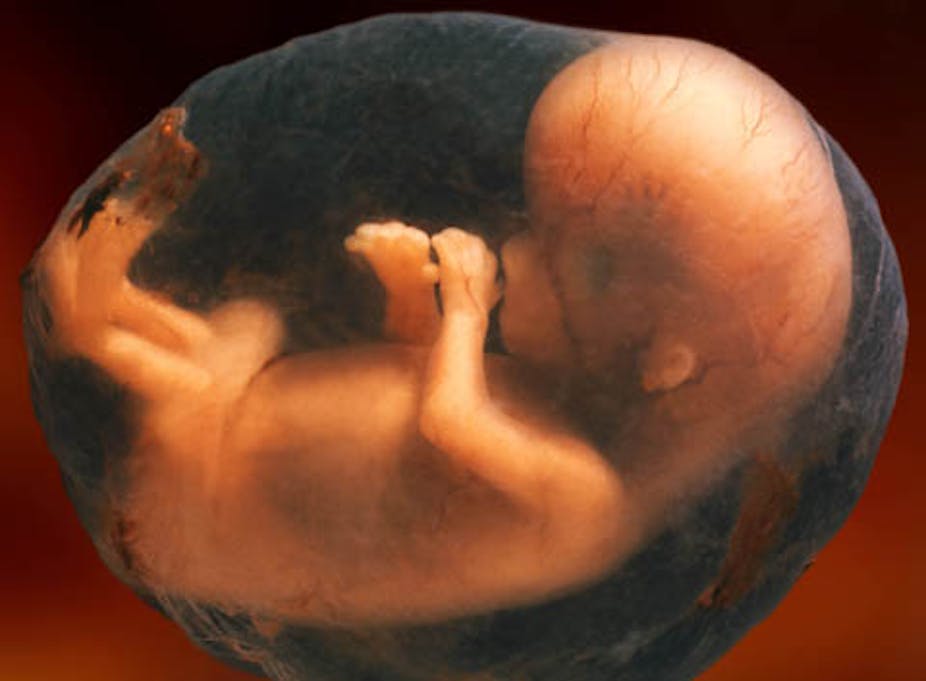Performing surgery on foetuses while still in the womb is a risky business. Although pioneering work in this field began in the 1980s, it remains very challenging, with only a few highly trained teams scattered around the world treating a handful of conditions. But new technology could transform the treatment of congenital problems in the womb.
In spina bifida, for example, part of the spinal cord and nerves may come through the spine of the foetus. This may cause both nerve and brain damage as it may block proper fluid drainage between the brain and the spinal cord. Having no prenatal surgery runs the risk of potentially serious neurological problems in the developing baby but surgery, which currently involves making a large opening incision in the mother’s abdomen and uterus, can lead to premature birth.
It is one of the most common birth defects but also one of the most complex procedures to carry out. Open prenatal repair is rare and has never been performed in the UK, for example.
Three-fingered device
Our goal is to make foetal surgery safer and more accessible to a broader set of surgeons. To do this, we’re working to develop a device, part of a £10m project bringing together world-renowned experts in foetal surgery, robotics, physics, optics and medical image computing.
The device will enable surgeons to operate from outside the womb using an extended flexible roboticised arm fed in through a small incision in the abdomen of the mother. Three fingers will give the surgeon even more dexterity and better vision at the surgery site. While two of the fingers can carry out procedures – in the case of spina bifida, patching up the source of the protrusion from the spine – the third may carry an innovative endoscopic imaging device to create 3D images of the womb to assist the surgeon. The images will appear on a screen visible to the surgeon and will help surgeons actively work in a difficult environment where the foetus might move for example. The images will also serve as a feedback for guiding the roboticised arm.

Some foetal surgery already involves passing surgical tools through a smaller incision in the abdomen and uterus. This minimises the risks of complications for the mother and foetus, notably preterm labour.

Minimal access with laser coagulation, for example, is the current standard of care for treating twin-to-twin transfusion syndrome (TTTS), a condition where two identical twins share blood through the same placenta. While the donor twin is deprived of blood and can develop growth defects, the other twin is overloaded with blood and can suffer from heart failure. To operate, surgeons currently use a foetoscope that acts like a long stick-shaped camera with a laser coagulator attached to it to cauterise the blood vessels that link the blood circulation between the twins, but this tool lacks flexibility and this kind of surgery is still quite complex and has limited access possibilities.
Minimally invasive surgery can also be used to stimulate lung growth in another condition called congenital diaphragmatic hernia. However a subsequent more invasive procedure called ex utero intrapartum treatment procedure, or “EXIT surgery”, might then be required at the time of the baby’s delivery.

While minimally invasive repair of spina bifida is possible, it remains inaccurate, has a high failure rate and requires multiple small incisions, which increases the risks associated with the procedure.
Our flexible robotised arm project has been designed to allow surgeons to perform minimally invasive surgery in all these scenarios with improved safety and efficacy compared to the options we currently have today.
Latest developments in robotics
We will build on the latest developments in robotics, for example using fluid hydraulic systems to create movement with motors that have a much smaller footprint than the standard ones. Although we do not intend to make the robotic arm fully automated, image guidance will be used to intelligently assist the surgeon. The design will, for example, help lessen tremors in the surgeon’s hand and allow for bigger or more fine-grained manipulation by scaling down the surgeon’s gestures.
The 3D imaging that will be used is based on photo acoustics. Photo-acoustic imaging is a hybrid technique that employs harmless laser pulses that enter deep into the tissue and convert into sound waves that can be detected by ultrasound. Combining this with conventional ultrasound technology will give a unique visualisation of both structural and functional information of the foetus in its environment.
Surgeons will be able to use external 3D ultrasonography as well as MRI, when available, to construct a plan for the operation based on the specific anatomy and pathology of the foetus to be operated on. Computer modelling embedded with biomechanical information will be able to compute and predict deformations that may occur during surgery. Both the pre-operative data and the feedback from the “live” 3D imaging will be fed into the model and processed to give surgeons ongoing context, much like a GPS might tell us where we are on a predefined map.
By combining these elements, we will provide surgeons with instrumentation that will help them make the surgery much safer and much more efficient. The surgeon will still be at the centre of the operation but will be able to rely on additional guidance, like you might get power steering, collision detection and rear cameras in a modern car.
Severe congenital defects account for many baby deaths each year but many more could survive if help could be given in the womb. Instead of carrying out neonatal surgery when it may be too late, pioneering new technology could transform this field of surgery.

